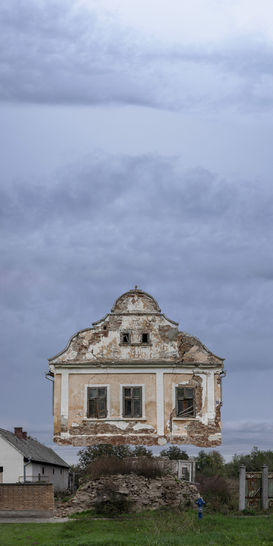Neudorf
2025
HR
Naglom industrijalizacijom Slavonije u 19. st. započinje veliki val naseljavanja Nijemcima, Mađarima, Srbima, Rusinima, Slovacima, Česima, Židovima, Austrijancima, Romima, ponešto Talijanima i Slovencima, kao i Hrvatima iz drugih regija. Formiraju se velika sela u nove etničke, gospodarske, urbanističke, kulturne i konfesionalne zajednice. Novo Selo ili njem. Neudorf je čest naziv za naselja nastala kolonizacijom.
Pečat promjene bila je arhitektura sela - utjecajem doseljenika, posebice Nijemaca, nastaje novi tip kuća. Svi objekti su strukturno jednaki, prilagođeni podneblju i lokalnom životu, a svojim historicističkim fasadama svaki je jedinstven. Na taj način reflektiraju različite identitete zatečene u istim životnim okolnostima. Možda i više nego druge, ove kuće su građene sa vjerom u bolju budućnost. Međutim, kroz 20. stoljeće na ovom prostoru niz ratova i ideologija postupno i temeljito brišu svu etničku raznolikost, ljude i njihove domove.
Duži niz godina fotografijom bilježim preostale povijesne seoske kuće od kojih su se mnoge, zbog derutnosti, nakon fotografiranja urušile. Serija fotografija se sastoji upravo od tih „mrtvih“ kuća koje apliciram na nedavno snimljene lokacije na kojima su se nalazile, iznad vlastitih ruševina. Povijest je pokazala neutemeljenost idealizma koji je u njih ugrađen. Aktualno iseljavanje i demografski slom preostalih Hrvata ostavlja iza sebe prazan prostor Slavonije u kojem su te kuće ruševine prostora života i suživota.
ENG
With the rapid growth of industry in the 19th century, Slavonia (a region in Croatia) was populated by numerous ethnic groups from Central and Eastern Europe. Large villages were formed into new ethnic, economic, urban, cultural and confessional communities. New Village or Neudorf (German) is a common name for settlements created by colonization.
The most visible consequence of the change was the vernacular architecture of the village. Under the influence of the settlers, a new type of houses emerged, all of which were structurally the same - adapted to the local climate and life, but each one was unique with its historicist facades. In this way, they reflect different identities found in the same living circumstances. Perhaps more than others, these houses were built with faith in a better future. However, throughout the 20th century, a series of wars and ideologies in this area gradually and thoroughly erased all ethnic diversity, people and their homes.
For years, I have been photographing the remaining traditional village houses, many of which, due to deterioration, collapsed after being photographed. The series of photographs consists of these "dead" houses that I apply to recently photographed locations where they once stood, above their own ruins. History has shown that the idealism built into them is ungrounded. The current emigration and demographic collapse of the remaining Croats leaves behind an empty space of Slavonia in which these houses are ruins of a space of life and coexistence.






